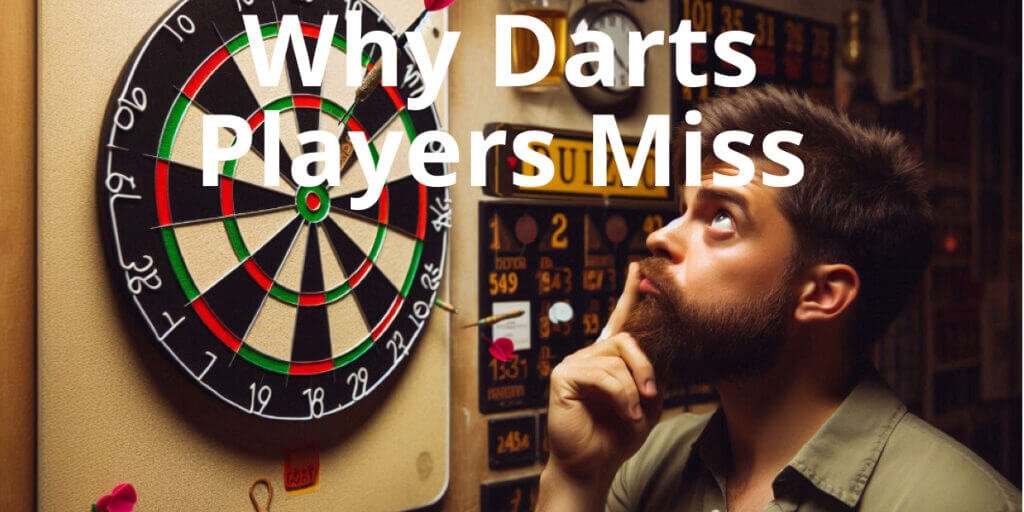In darts, accuracy and consistency are essential for success, but every darts players miss from time to time. Whether you’re a beginner or a seasoned player, understanding why you sometimes miss your target is key to improving your game.
Here, we explore some common reasons players miss their mark and how you can tackle each one.
1. Inconsistent Stance and Posture
- The Problem: Your stance serves as the foundation of your throw. If your stance or posture varies even slightly, it can affect your aim and release.
- Solution: Find a stance that feels balanced and comfortable, and stick to it. Typically, players stand at a 45-degree angle to the dartboard with their dominant foot forward. Make sure your body remains stable and your core engaged. Practicing this posture will help you avoid shifting your weight unintentionally during a throw.

2. Grip Issues
- The Problem: The way you hold the dart can make or break your throw. A grip that’s too tight can lead to tension, while one that’s too loose can lack control.
- Solution: Experiment with different grips to find one that’s comfortable and stable. Most players prefer a grip that allows them to lightly cradle the dart without any tension. Consistency is key, so once you find a comfortable grip, use it consistently in all your throws.
3. Rushing the Throw
- The Problem: Impatience or excitement can lead to rushed throws, which often results in a lack of focus and missed targets.
- Solution: Develop a pre-throw routine to help you calm down and focus. This can include deep breathing, visualizing the target, and aligning your body. Take a moment to center yourself before each throw, and aim to repeat this process consistently.
4. Lack of Follow-Through
- The Problem: The follow-through is often neglected by newer players who may let go of the dart without finishing their arm motion. This interruption can easily throw off the dart’s trajectory.
- Solution: After releasing the dart, allow your throwing arm to extend fully towards the dartboard, creating a smooth arc. The follow-through helps maintain direction and keeps your shot straight, making it easier to hit your target.
5. Eye Dominance Mismatch
- The Problem: Eye dominance affects where you naturally aim. If your throwing hand and dominant eye don’t align, it can lead to an unintentional angle in your aim.
- Solution: Test your eye dominance by extending your thumb in line with a distant object and closing one eye at a time. Whichever eye keeps your thumb aligned with the object is your dominant eye. Adjust your stance to align this eye with the target if you’re struggling to stay consistent with aim.
6. Mental Distractions
- The Problem: External distractions or internal thoughts can break your focus, leading to inconsistent or rushed throws.
- Solution: Mental discipline is crucial in darts. Many players use techniques such as deep breathing, visualization, or even short mindfulness exercises before a game to maintain a clear head. If you’re in a noisy environment, practice tuning out distractions. Over time, you’ll be able to stay in the zone, even in a competitive atmosphere.
7. Physical Fatigue and Muscle Tension
- The Problem: Fatigue can affect your grip, your stance, and your ability to hold a steady arm, which results in missed throws.
- Solution: Building endurance through regular practice can help you maintain strength over long sessions. Taking short breaks between rounds can also prevent fatigue from setting in too early. Practicing relaxation techniques, like shaking out your arms or doing a quick stretch, helps release built-up muscle tension and keeps you loose.
8. Improper Release Timing
- The Problem: Releasing the dart too early or too late can completely change its flight path, leading to wild shots and missed targets.
- Solution: Finding your optimal release point takes practice. As a general guideline, aim to release the dart at the moment your hand is pointed directly at the target. Recording yourself can help identify whether you’re releasing too early or too late. Practice focusing on this part of the motion until it becomes second nature.
9. Overthinking Your Shot
- The Problem: Overanalyzing each aspect of your throw can lead to tension and hesitation. This analysis paralysis often results in poor throws because you’re too focused on the details instead of the target.
- Solution: Train yourself to trust your muscle memory. Developing a consistent routine will help your body learn what feels right. Once you’re in front of the dartboard, focus on the target rather than the mechanics. Allow your training and instincts to take over instead of overthinking.
10. Lack of Practice or Improper Practice
- The Problem: Without consistent, deliberate practice, it’s difficult to build the muscle memory required for accuracy. Practice that lacks focus can also reinforce bad habits.
- Solution: Set aside regular practice time and structure it to cover various aspects of the game. Practice from different positions on the board, focus on specific targets, and work on checkout strategies. Drills that simulate game scenarios can help prepare you for pressure situations, allowing you to perform better when it counts.
Building a More Accurate Throw
Improving accuracy in darts is about consistency in mechanics, mental clarity, and an understanding of what may be going wrong. Whether it’s refining your stance, calming your mind, or training with purpose, each adjustment will bring you closer to mastering those high-scoring, on-target throws.
Incorporating these techniques into your practice routine will allow you to hone in on each area and develop a natural, accurate throw. By addressing and correcting these common issues, you’ll be better equipped to hit your target and improve your darts game significantly. Remember, every miss is an opportunity to learn, so embrace each throw as part of your journey to becoming a more consistent and accurate darts player.





